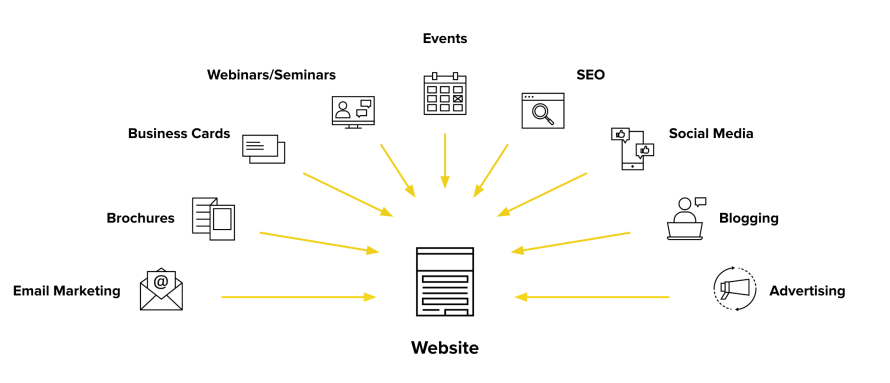Why Web Teams Are Wedded to an Approach Invented in the ’90s
Image

Here is how the digital marketing landscape as we know it was formed:
2005: The rise of Google. Suddenly marketers had the power to know which ads worked (and which didn’t), and they could turn off the bad performers and invest in the ones that performed.
2010: The rise of inbound content marketing. Suddenly marketers could create and publish owned content and digital products to drive organic demand.
2012: The rise of social marketing. Suddenly marketers could participate directly in conversations and news events in the public sphere to drive attention.
Each of these industry inflections was brought about by software products that marketers could control directly.
Notice something missing? Yeah, the freaking website!
That’s because websites predate digital marketing. We solidified our approach, technologies, and mindset about how to manage websites way back in the 1990s—before the rise of digital marketing—and haven’t examined the thinking since.
Meanwhile, there has been a Cambrian explosion of digital marketing tools, methodologies, and new innovations happening around the website, while the website (which is where everything links back to and converts) has barely budged in terms of technology innovation.
Image

Let's take it back to the twentieth century, where we “figured out websites.”
In the ’90s, IT teams owned the website, because the website was technology, after all, and IT owned all technology. They used traditional hosting (racking servers, installing software, and managing software). They used traditional approaches: waterfall project management that meant months or even years of work toward one high-stakes release. And, when something broke, they had to fix it.
Sound familiar? Yeah, because it’s barely changed.
Meanwhile, every other digital marketing channel is backed by great software products.
Think about how easy it is to send targeted emails to groups of customers: Draft a message—maybe in a nice template—type a list address in the To field, and hit Send. Mail two versions and learn from A/B testing. Monitor who opens the email. Monitor who clicks on what links in that email, and where they went next. Iterate for better results and try again.
Or access more than 2 billion social media users around the world via marketing “stories” or interactions on Facebook, Snapchat, Instagram, Twitter, and other social channels and track every response (or lack thereof). Iterate for better results and try again.
Target segmented audiences with digital advertising—banners on websites your targets might visit, ads on Google and Yahoo, etc. Track clicks and click-throughs and compare success rates. Iterate for better results and try again.
In 2019, worldwide digital ad spending will rise by 17.6% to $333.25 billion, according to a recent report by eMarketer, with Google, Facebook, and Amazon topping the list of digital ad sellers worldwide. And where do your ads, tweets, and “stories” send consumers from those slick multimillion dollar digital platforms on which you’ve spent and overspent your marketing budget? To your corporate website—where visitors expect the same lightning-fast downloads; intuitive, personalized content; and contextualized offers.
But you can’t meet those expectations, because you can’t iterate your twentieth-century website. Website requests from marketers fall into a queue in which engineering and product-team demands take priority. Which means a large percentage of your digital ad spend is probably going down the drain. The content on your website may be irrelevant or hard to find. Response may be slow or nonexistent because the site can’t scale. Visitor experience might vary depending on the device that visitor is using as an entry point. And if they have a bad experience, 88% of visitors are not likely to give you a second chance.
So, what’s the alternative?
Agile. Here is how agile development puts you, the marketer, in the driver’s seat:
- Instead of waiting for help, you control your destiny.
- Instead of quarterly cycles, you’re changing, testing, and learning continuously.
- Instead of your website being the last thing to be leveraged, you can leverage your website at the speed of social.
To get to this promised land, you need to throw out all of your ’90s thinking.
Your website is a digital product. So manage it like a digital product: make the job of the person who owns the website that of a “product manager.”
Marketers need to fully own the website, with IT acting as their partner. They need the confidence to manage production of the website, with control of their own team of developers, designers, and product managers responsible for hooking up a stack of technologies and making sure every marketer is empowered to use them, unencumbered. They need to use this stack to create a digital experience layer across all touchpoints: ads, website, email, and mobile. And, they need to drive toward their goals for the website in an agile, iterative way. The way they do with their other (twenty-first century) digital marketing tools, such as email and social.
WebOps to the Rescue
The only way you can take that modern, agile approach to your website is by adopting a WebOps strategy, with a team responsible for the deployment, monitoring, and overall operations of your mission-critical web applications. If you don’t have a tool in place that enables your team to collaborate, work together, and make and deploy changes quickly, it’s impossible to take this iterative approach in which you can test, tune, and change the digital experience on a daily basis.
A WebOps team uses agile development methods, breaking projects into short weekly sprints with continual releases as features are ready. They meet with project teams and business owners daily during a project. They re-prioritize continuously based on results. They respond to change rather than following a rigid plan. WebOps is what enables a website to be a twenty-first century digital marketing tool, and not just a twentieth-century website. It’s what puts marketers in the driver’s seat, where they belong. If you need more evidence, read about some of the companies who’ve taken the WebOps road to digital transformation.


